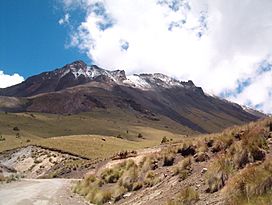Zacatonal facts for kids
Quick facts for kids Zacatonal |
|
|---|---|

Zacatonal on Nevado de Toluca
|
|
| Ecology | |
| Realm | Neotropical |
| Biome | montane grasslands and shrublands |
| Borders | Trans-Mexican Volcanic Belt pine-oak forests |
| Bird species | 204 |
| Mammal species | 48 |
| Geography | |
| Area | 306 km2 (118 sq mi) |
| Country | Mexico |
| Conservation | |
| Conservation status | Relatively stable/intact |
The Zacatonal is a special type of ecoregion found in central Mexico. It is a high-altitude area with lots of grasses and shrubs. Think of it as a unique natural home for many plants and animals.
Contents
Where is the Zacatonal located?
The Zacatonal is made up of several separate areas. These areas are found on the highest parts of the Trans-Mexican Volcanic Belt. This is a chain of volcanoes that runs across Mexico. The Zacatonal covers about 306 square kilometers (118 square miles).
You can find Zacatonal areas above 3,500 meters (about 11,500 feet) high. They are on famous volcanoes like Popocatépetl, Iztaccihuatl, Malinche, Nevado de Toluca, Cofre de Perote, Pico de Tancítaro, and Pico de Orizaba. Below these high Zacatonal areas, you'll find the Trans-Mexican Volcanic Belt pine-oak forests.
What is the climate like in Zacatonal?
The weather in the Zacatonal changes with height. At lower elevations, it is mild and a bit humid. As you go higher up the mountains, the climate becomes alpine. This means it's much colder, like in the mountains, but still a bit humid.
Plants of the Zacatonal
The main type of plant life here is grassland. These grasslands range from subalpine (just below the tree line) to alpine (very high up).
Subalpine Grasslands
Around 3,500 meters high, you'll see a mix of forests and grasslands. Here, you might find open forests of Hartweg's pine (Pinus hartwegii) or Montezuma pine (Pinus montezumae). These trees mark the change from the lower pine-oak forests to the subalpine grasslands.
The grasslands themselves are mostly covered by grasses like Toluca fescue (Festuca tolucensis) and Toluca reedgrass (Calamagrostis tolucensis). These grasses grow under the pines, in open areas with Juniperus monticola trees, or as wide-open grasslands.
Other plants you might see include:
- Arenaria bryoides
- Descurainia impatiens
- Draba jorullensis
- Lupinus montanus
- Muhlenbergia pusilla
- M. quadridentata
- Oxalis species
- Pedicularis orizabae
- Penstemon gentianoides
- Poa annua
- Potentilla staminea
- Sicyos parviflorus
- Trisetum spicatum
At about 3,800 meters, Muhlenbergia quadridentata becomes the most common grass. Between 3,800 and 4,200 meters, Calamagrostis tolucensis takes over as the main grass.
Alpine Grasslands
The change from subalpine to alpine grasslands happens between 4,200 and 4,300 meters high. Alpine grasslands are dominated by grasses like Festuca livida and Arenaria bryoides.
Other plants found in this very high alpine zone include:
- Festuca tolucensis
- Species of Carex
- Cerastium
- Cirsium
- Draba
- Eryngium
- Gnaphalium
- Lupinus
- Luzula
- Oxylobus
- Phacelia
- Plantago
- Potentilla
- Ranunculus
- Senecio
You can also find ferns, mosses, and lichens growing here. The plants in the Zacatonal are very special. Many of them are found nowhere else in the world! They are different from alpine grasslands in North America and the high-altitude páramo areas in Central and South America.
Animals of the Zacatonal
The Zacatonal is home to several unique animals.
Birds
The Sierra Madre sparrow (Xenospiza baileyi) lives in the area where the Zacatonal meets the pine forests.
Mammals
Some native mammals that call Zacatonal home include:
- The Mexican volcano mouse (Neotomodon alstoni)
- The volcano harvest mouse (Reithrodontomys chrysopsis)
- The volcano rabbit (Romerolagus diazi)
- Cryptotis goldmani alticola, which is a type of Goldman's broad-clawed shrew.
Protecting the Zacatonal
Sadly, some of the grasslands in Zacatonal are not in good shape. This is because of too much grazing by farm animals or uncontrolled fires.
However, there's good news! In 1935, the Mexican government took action. They protected nearly 4,000 square kilometers (about 1,500 square miles) of the mountains around the Valley of Mexico. This protected area includes both the high Zacatonal grasslands and the lower pine-oak forests. This helps keep these special places safe for the future.
See also
 In Spanish: Zacatonal para niños
In Spanish: Zacatonal para niños
- List of ecoregions in Mexico

